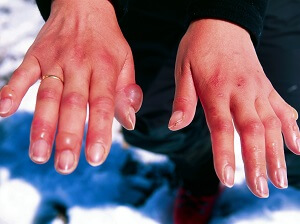Anyone working in a cold environment may be at risk for cold stress. This could include an indoor workplace like cold storage or an outdoor job in construction or agriculture.
Prolonged exposure to cold and/or freezing temperatures while on the job may cause serious health problems such as trench foot, frostbite and hypothermia. In extreme cases, exposure to cold temperatures can lead to death.
Although OSHA does not have a specific standard that covers working in cold environments, under the Occupational Safety and Health Act (OSH Act) of 1970, employers have a duty to protect workers from recognized hazards, including cold stress hazards, that are causing or likely to cause death or serious physical harm in the workplace.

To learn more about how to prevent cold stress, read more here. Anyone working in a cold environment should be familiar with common types of cold stress illnesses and injuries so that if they notice signs and symptoms, they can act immediately to prevent serious health problems or worse.
Common Types of Cold Stress
Hypothermia is when the normal body temperature (98.6⁰F) drops to less than 95⁰F. Exposure to the cold causes the body to lose heat faster than it can be produced. Hypothermia can occur at temperatures above 40⁰F if one is chilled from rain, sweat or cold water.
Symptoms include uncontrollable shivering, loss of coordination, confusion and slurred speech.
First Aid: Move the worker to a warm, dry area, remove wet clothing and replace with dry clothing, wrap the entire body in layers of blankets and seek medical attention immediately.

Frostbite occurs when body tissues freeze and this can occur at temperatures above freezing due to wind chill and may result in permanent damage or amputation. Frostbite typically occurs on fingers, toes, nose and ears.
Symptoms include numbness, red skin that may develop gray/white patches, skin feels hard, sometimes blisters.
First Aid: Protect the area affected by wrapping it loosely in a dry cloth. Do not rub it, do not apply snow or water, do not break blisters and do not attempt to re-warm the area. Seek medical attention immediately.

Trench Foot is injury to the feet caused by exposure to wet and cold conditions. Wet feet lose heat 25x faster than dry feet and workers can get trench foot in temperatures as high as 60 degrees F if feet are constantly wet.
Symptoms including tingling, pain, swelling, cramps, numbness and blisters.
First Aid: Remove wet shoes/boots and socks, dry the feet, avoid walking, keep the feet elevated and seek medical attention.
.jpeg)

.jpeg)